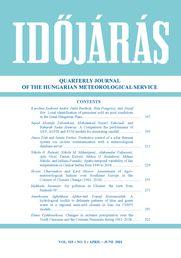IDŐJÁRÁS - angol nyelvű folyóirat
Vol. 125, No. 2 * Pages 167–336 * April - June 2021
 |
|
 letöltés [pdf: 4520 KB]
letöltés [pdf: 4520 KB]
Local identification of persistent cold air pool conditions in the Great Hungarian Plain
Karolina Szabóné André, Judit Bartholy, Rita Pongrácz, and József Bór
DOI:10.28974/idojaras.2021.2.1 (pp. 167–192)
Karolina Szabóné André, Judit Bartholy, Rita Pongrácz, and József Bór
DOI:10.28974/idojaras.2021.2.1 (pp. 167–192)
Comparison of the performances of GEP, ANFIS, and SVM artifical intelligence models in rainfall simulaton
Seyed Mostafa Tabatabaei, Mohammad Nazeri Tahroudi, and Bahareh Sadat Hamraz
DOI:10.28974/idojaras.2021.2.2 (pp. 195–209)
Seyed Mostafa Tabatabaei, Mohammad Nazeri Tahroudi, and Bahareh Sadat Hamraz
DOI:10.28974/idojaras.2021.2.2 (pp. 195–209)
Predictive control of a solar thermal system via on-line communication with a meteorological database server
János Tóth and István Farkas
DOI:10.28974/idojaras.2021.2.3 (pp. 211–227)
János Tóth and István Farkas
DOI:10.28974/idojaras.2021.2.3 (pp. 211–227)
Spatiotemporal variability of air temperatures in Central Serbia from 1949 to 2018
Nikola R. Bačević, Nikola M. Milentijević, Aleksandar Valjarević, Ajša Gicić, Dušan Kićović, Milica G. Radaković, Milena Nikolić, and Milana Pantelić
DOI:10.28974/idojaras.2021.2.4 (pp. 229–253)
Nikola R. Bačević, Nikola M. Milentijević, Aleksandar Valjarević, Ajša Gicić, Dušan Kićović, Milica G. Radaković, Milena Nikolić, and Milana Pantelić
DOI:10.28974/idojaras.2021.2.4 (pp. 229–253)
Assessment of agrometeorological indices over Southeast Europe in the context of climate change (1961–2018)
Hristo Chervenkov and Kiril Slavov
DOI:10.28974/idojaras.2021.2.5 (pp. 255–269)
Hristo Chervenkov and Kiril Slavov
DOI:10.28974/idojaras.2021.2.5 (pp. 255–269)
Air pollution in Ukraine: a view from the Sentinel-5P satellite
Mykhailo Savenets
DOI:10.28974/idojaras.2021.2.6 (pp. 271–290)
Mykhailo Savenets
DOI:10.28974/idojaras.2021.2.6 (pp. 271–290)
A hydrological toolkit to delineate patterns of blue and green water in a regional semi-arid climate in Iran via CMIP5 models
Amirhosein Aghakhani Afshar and Yousef Hassanzadeh
DOI:10.28974/idojaras.2021.2.7 (pp. 291–319)
Amirhosein Aghakhani Afshar and Yousef Hassanzadeh
DOI:10.28974/idojaras.2021.2.7 (pp. 291–319)
Changes in extreme precipitation over the North Caucasus and the Crimean Peninsula during 1961–2018
Elena Vyshkvarkova
DOI:10.28974/idojaras.2021.2.8 (pp. 321–336)
Elena Vyshkvarkova
DOI:10.28974/idojaras.2021.2.8 (pp. 321–336)
IDŐJÁRÁS folyóirat

Az IDŐJÁRÁS a HungaroMet Nonprofit Zrt. negyedévenként megjelenő angol nyelvű folyóirata
Megrendelhető a journal.idojaras@met.hu címen.
A szerzőknek szánt útmutató itt olvasható.
Megrendelhető a journal.idojaras@met.hu címen.
A szerzőknek szánt útmutató itt olvasható.









